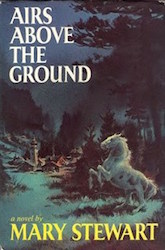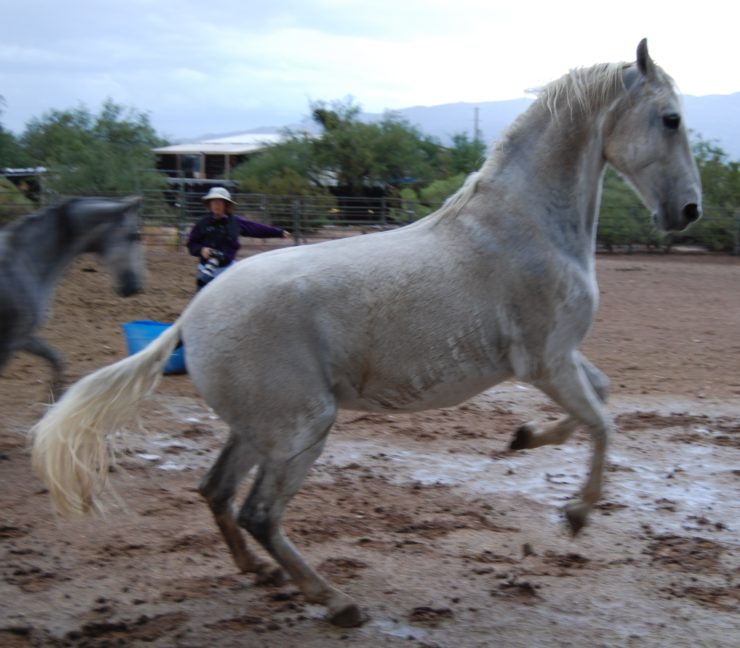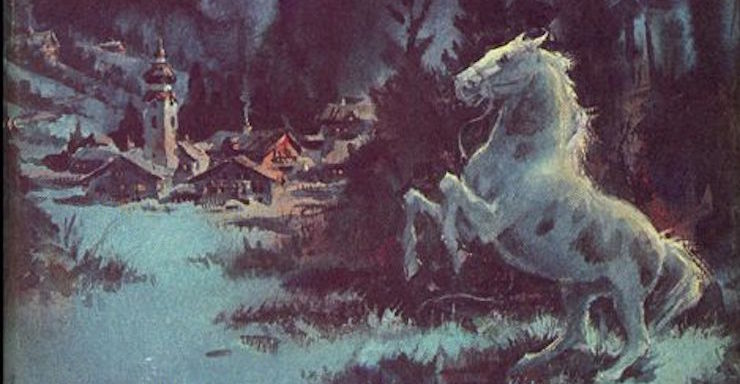If you ask a Lipizzan enthusiast in the US how they first became enamored of the breed, there’s a very short list of books and films that comes up immediately. Prominent on that list is the Disney film, “The Miracle of the White Stallions,” and Mary Stewart’s 1965 suspense novel, Airs Above the Ground.
Stewart was not, as far as I know, a horse person, and the book is not a horse book. It’s about a young woman searching for her husband in the Austrian countryside, and international drug smuggling, and, incidentally, one of Austria’s greatest treasures, the Lipizzan horses of the Spanish Riding School of Vienna. In the mid-Sixties, between the film and the Spanish Riding School’s 1964 tour of the US, the Dancing White Horses of Vienna were very much in the news, and Stewart seems to have caught the bug along with many others. Being Mary Stewart, superb writer of romantic suspense, she did her homework thoroughly, and built a thriller plot around the magical white horses.
Veterinary surgeon Vanessa has been married for two years to international businessman Lewis, and since it’s 1965, that means she’s pulled back from her career and plans to drop it completely once they start a family. Meanwhile she’s still poking at it now and then, just keep her hand in, and being bored and frustrated because Lewis was supposed to take her on holiday to Italy and has been called back to work.
A family friend begs her to chaperone the friend’s teenaged son to Austria where he’ll be meeting his estranged father; the friend expects that Vanessa is going to meet Lewis there. Vanessa has been led to believe that Lewis is in Sweden, but the friend has seen him on a newsreel in Austria, involved in a fire at a circus—and when Vanessa investigates, she immediately notices the luscious young blonde he’s comforting.
 So off Vanessa goes with sullen and resentful young Timothy, to find out exactly what Lewis is up to. Tim is a lover of horses and specifically the Lipizzans, and he’s a fount of information about them. His life’s dream is to get “a job” at the Spanish Riding School, though he’s never quite clear as to what that job would be.
So off Vanessa goes with sullen and resentful young Timothy, to find out exactly what Lewis is up to. Tim is a lover of horses and specifically the Lipizzans, and he’s a fount of information about them. His life’s dream is to get “a job” at the Spanish Riding School, though he’s never quite clear as to what that job would be.
Once they’re in Vienna, Tim’s family situation turns out to be much more complicated than he admitted. His father isn’t expecting him—and Vanessa reveals that Lewis isn’t expecting her, either. By then they’re fast friends and allies, and they decide to rent a car and head toward Graz, Tim because it’s near the Lipizzaner stud at Piber, and Vanessa because the circus is in the area.
Amid the lushly described details of Austrian landscape, Tim and Vanessa find themselves in the middle of several international incidents, including the circus fire that killed an elderly horsemaster and one of Lewis’ colleagues, a gang of drug runners, and a Lipizzan stallion stolen from the Spanish Riding School.
The thriller plot is thrilling, I suppose, but that’s not what I came to the book for. Rereading it made me think of the framing story of The Princess Bride. There’s a whole book full of plot and wordage, but I’m reading it for the good parts. Which are, naturally, the horses.
As with The Princess Bride, there’s not all that much to the good-parts version. A full third of the book is a long night’s chase over castle battlements and through moonlit Alpine scenery, with death-defying feats of driving, shooting, and Tim getting his foot caught in a cog railway and needing a desperate, last-ditch run to save him before the train runs him over. Wow. Thrilling. See my excited face.
There’s a saying among readers of teen books. “Too much boyfriend, not enough roller derby.” Here it’s “Too much drug chase, not enough Lipizzaner.”
Even so, the good parts are so very good. When I read the book as a teen, I knew a little about Lipizzans, but I learned quite a bit more from the threads Stewart wove into her story. Tim sums up the breed and its history concisely and clearly, and that leads us into the circus, where the young woman, Annalisa (who is not having an affair with Lewis at all, much to Vanessa’s relief), does exhibition rides on her stallion, Maestoso Leda. They’re a dim approximation of the performances in Vienna, with flashy glass jewels on the saddle and the rider in a hussar’s uniform, but they have their charm.
For me, having seen the traveling shows in the US—the Herrmann family show and the “World-Famous Lipizzaner Stallions” out of Florida—these scenes are rather evocative and strikingly prescient. To this day there are young women in hussar-like uniforms riding performances at Tempel Lipizzans outside of Chicago, just like Annalisa.
At the time I first read the book, I didn’t even dream of owning my own Lipizzan. These horses were as magical as McCaffrey’s dragons or Tolkien’s elf-horses, and as unattainable.
And magic is what Stewart gives us. The plot that captivates me, the story that brings me back again and again, is by word count quite a small part of the story, but it shines brilliantly in memory.
The story that comes out through Vanessa and Tim’s investigations is that a young man joined the School at Wels and became a rider-candidate, but he had a serious drinking problem and was fired. He was said to have committed suicide, but in fact he disappeared, as did one of the stallions, Neapolitano Petra, who was an Airs horse; his Air was the levade.
Vanessa unravels the mystery after meeting Annalisa and being invited to attend a performance. When she goes backstage after, she comes across an old piebald horse who belonged to the deceased horsemaster, who was injured in the fire and who is in danger of being put down. Vanessa operates on the horse’s leg and talks the circus owner into letting him live.
The truth comes out when Vanessa takes the old stallion out to graze during the afternoon performance. When the music for Annalisa’s ride comes on, the horse starts to dance. He’s stiff, he’s rusty, but he knows all the movements. And at the end, he performs the levade.
This isn’t any old cart horse. Vanessa urges Tim to join her during the evening performance, to get his horseman’s eye on the proceedings. And there in the moonlight, old Piebald performs the steps and movements of the high school, and finishes with the levade. In that light, it’s clear the black patches are dyed, and the horse is a Lipizzan.
Tim knows what to look for, to prove it. They find the brands under the black patches: the L on the cheek for Lipizzan, the crowned P on the haunch for Piber, and the two symbols in the saddle area for the horse’s lineage: Neapolitano for the sire, and the male line of his dam, Petra.
The old horsemaster was the runaway rider, and the horse nobody paid attention to is the lost Lipizzan. His training was kept up in private over the years, but never in public for fear of betrayal.
Vanessa and Tim convince the circus to release the horse to them, and promise to return him to Vienna. Hence the castle, where the old horse is given stable room, though he’s turned out on pasture and forgotten while the chase goes on.
What’s wonderful about these scenes is how deeply true they are. Even dumping him in the pasture—for his particular injury, moving around is what he needs, and shutting him up in a stall will make him worse. But the one we all remember, the one that’s burned into our horse-fanatical brains, is the old horse dancing by himself, first in the sunlight, and then under the moon:
As the stallion rose in the last magnificent rear of the levade, the moonlight poured over him, bleaching his hide, so that for perhaps five or six long seconds he reared against the black background, a white horse dappled with shadows, no longer an old broken-down gypsy’s piebald, but a haute école stallion, of the oldest line in Europe.

It’s not just that he’s so thoroughly trained. It’s that this is what he is. He hears the music, he has to dance.
It’s also true that standing by themselves, just being horses, Lipizzans can be fairly unimpressive. As Vanessa notices when she meets Maestoso Leda backstage, they’re short, stocky, and their profiles tend toward the convex, which has gone out of fashion. It’s not hard for one to be mistaken for a cart horse, especially if he’s depressed from the loss of his rider and has been hurt.
The story is that the rider stole him out of spite, to get back at the School for firing him, but there’s an undertone of deeper truth, and that’s where my head canon goes. The bond between the rider and his (and in recent years her) horse is deep and strong. Anne McCaffrey based the bond between dragon and dragonrider on it. I think Franz stole Neapolitano Petra not only because he was drunk and furious, but because he couldn’t bear to be parted from him.
In the book, once the horse leaves the circus and Tim leads him up to the castle, that’s it for him until the very short epilogue in which Vanessa, Tim, and Lewis sit in the royal box for Neapolitano Petra’s return to the Spanish Riding School. There’s one more truth here, one more thing that shows how well Stewart understood. When the horse performs, he doesn’t whicker to Vanessa, or even seem to see her, though he’s clearly fond of her and grateful for what she did for him. He’s gone into his own space.
The eyes, like the stallion’s whole bearing, were absorbed, concentrated, inward, his entire being caught up again and contained in the old disciplines that fitted him as inevitably as his own skin.
Yes. So very yes. That’s it exactly.
We never do find out whether Tim gets a job and if so, what it is; we never see how the School reacts to the news that its missing stallion has been found. But one thing we do know. We’re told this several times, and that’s the note we end on:
The lights dimmed, and the white horse dwindled down the corridor beyond the arch, to where his name was still above his stall, and fresh straw waiting.
The wonderful thing about all this, the thing that gave me bad blurry-page syndrome when I reread the book, is that it speaks to so much of what I live every day. Even the story of the rider who died—that has happened, and not terribly long ago, though I don’t know of any stallion who was ever stolen; they’re given as gifts to world leaders, and sold once in a great while to a long waiting list. But stallions who retire still receive visits from their riders, and the love between them is a strong and perceptible thing.
The magic is real. Stewart saw it, and wrote it beautifully. Even if she did allow herself to get terminally distracted by that endless chase scene.
As for Tim, I suspect she would have assumed he’d be taken on as a groom. But these days, at least until Brexit plays itself out, a seventeen-year-old (male or female) with an EU passport and fluent German is welcome to apply to the School as a rider-candidate. In fact one of the first two women admitted had dual US and UK citizenship. She didn’t stay; but the other did, and is now a full Bereiter.
So in my head canon, Tim becomes an Eleve, and eventually a rider, and maybe Neapolitano Petra will be one of his four-legged teachers. As for the horse himself, he lives out his life in the School, retires at a great age, and lives on for a while at Piber like his spiritual descendant, Neapolitano Nima, also a levade horse, who is now the oldest living Lipizzan, having just celebrated his 39th birthday.
This book is true on so many levels, from so many directions. And that’s a magic of its own.
Next time in my summer reading adventure, I’m moving on to another book I loved immoderately when I first read it: Joy Chant’s Red Moon and Black Mountain. It’s…problematical. But still, parts of it are too gorgeous almost to be borne.
Judith Tarr is a lifelong horse person. She supports her habit by writing works of fantasy and science fiction as well as historical novels, many of which have been published as ebooks by Book View Cafe. She’s even written a primer for writers who want to write about horses: Writing Horses: The Fine Art of Getting It Right. Her most recent short novel, Dragons in the Earth, features a herd of magical horses, and her space opera, Forgotten Suns, features both terrestrial horses and an alien horselike species (and space whales!). She lives near Tucson, Arizona with a herd of Lipizzans, a clowder of cats, and a blue-eyed dog.










